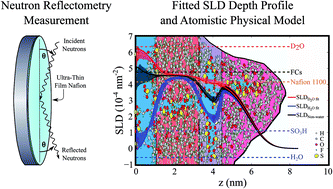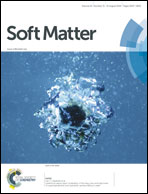Phase segregation of sulfonate groups in Nafion interface lamellae, quantified via neutron reflectometry fitting techniques for multi-layered structures†
Abstract
Neutron reflectometry analysis methods for under-determined, multi-layered structures are developed and used to determine the composition depth profile in cases where the structure is not known a priori. These methods, including statistical methods, sophisticated fitting routines, and coupling multiple data sets, are applied to hydrated and dehydrated Nafion nano-scaled films with thicknesses comparable to those found coating electrode particles in fuel cell catalyst layers. These results confirm the lamellar structure previously observed on hydrophilic substrates, and demonstrate that for hydrated films they can accurately be described as layers rich in both water and sulfonate groups alternating with water-poor layers containing an excess of fluorocarbon groups. The thickness of these layers increases slightly and the amplitude of the water volume fraction oscillation exponentially decreases away from the hydrophilic interface. For dehydrated films, the composition oscillations die out more rapidly. The Nafion–SiO2 substrate interface contains a partial monolayer of sulfonate groups bonded to the substrate and a large excess of water compared to that expected by the water-to-sulfonate ratio, λ, observed throughout the rest of the film. Films that were made thin enough to truncate this lamellar region showed a depth profile nearly identical to thicker films, indicating that there are no confinement or surface effects altering the structure. Comparing the SLD profile measured for films dried at 60 °C to modeled composition profiles derived by removing water from the hydrated lamellae suggests incomplete re-mixing of the polymer groups upon dehydration, indicated limited polymer mobility in these Nafion thin films.


 Please wait while we load your content...
Please wait while we load your content...